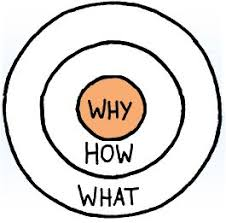Most accounting firms and businesses know what they do, and how they do it. But how many know why? In his viral Ted Talk, Simon Sinek tells us that it’s the why that is the most important of the three, and gives several famous examples to illustrate his point.
“People don’t buy what you do,” he says, “they buy why you do it.” Understanding why your company does what it does, and why you get out of bed in the morning to go to work, is an important part of reaching your goals.
But why do you need a why? And how do you find your why? And what happens when you have one?
Let’s take a closer look.
The Golden Circle: Starting with Why
Simon Sinek has a theory that he says changed his understanding of success: the golden circle. It’s a simple, life-altering idea, that looks like this:

Most businesses understand what they do, and how they do it, says Sinek. But not many operate on the why, and lead with their why first. Doing so makes a significant difference in how a company markets their services, their products, and themselves.
Here Sinek brings up a famous example: Apple. Here’s an example of Starting With Why in action:
| A Typical Marketing Pitch | Apple's Marketing Pitch |
|
We make great computers |
|
By reversing the order of the golden circle, and leading with why, Apple goes from simply selling a product, to selling a lifestyle.
What’s Our Why?
Leading with why isn’t limited to Apple however. Spotlight Reporting’s why is embedded in everything we do:
“To help transform a traditional, complacent industry into something incredible.”
This is the principle that our products are founded on. Similarly, this is Xero’s why:
“To make life better for people in small business, their advisors, and communities around the world.”
Other examples from businesses of various sizes, and various industries:
Asana: “To help humanity thrive by enabling all teams to work together effortlessly.”
Ikea: “To create a better everyday life for the many people.”
Tesla: “To accelerate the world’s transition to sustainable energy.”
Bellroy’s: “Because a fat wallet is literally a pain-in-the-a**”
Note that none of these whys are sales pitches. If you didn’t know the brand, you might not be able to tell what it is that they do (with the exception, perhaps, of Bellroy). But every single one of these whys is motivational, and every one of these companies exist to make life easier for their customers, their communities, and the world.
A why isn’t about monetary success, or the bottom line. It’s about legacy. What do you want yours to be?
Finding and Implementing Your Company’s Why
Now that we’ve accepted the importance of having a why, let’s discuss how to find a company’s’ why. It is important to note that a company's why and the personal whys of employees don’t have to align perfectly, but more often than not you’ll find that your most dedicated team members are the ones whose whys are synergistic with the company’s. For this reason, mining employees for their opinions could be very rewarding, both in identifying company culture, and surfacing a why.
A good why statement, for an individual and for a company, simply needs to fill in these blanks:
To ______ so that ______.
Start your journey by surveying team members, and ask them what they think the company’s why is. Have them write down their answer anonymously, then collate the answers you receive.
 The Spotlight Reporting Team
The Spotlight Reporting Team
2. Collate the results
Are there recurring themes across the answers? Are they wildly different to what you expected? If the most common response doesn’t align with the views of the partners or stakeholders, this is a problem with company culture. Why do your employees believe something different? Is this a chance for the company to recalibrate strategy and direction, and adopt a new why? Is there something in their answers that could really add to the company’s mission?
3. Finalise your why
Take all of this information, and find your company’s why. Make it simple, make it cohesive, and make sure it rings true for you.
4. Recalibrate your company
Now that there is a why, it’s time to look at the how and the what. Does what you do and how you do it align with why you do what you do? Are you satisfied with the trajectory of the company? Do you and your team look forward to going to work each day? If not, why not?
Understanding the company’s why (and indeed, your own personal why), is a chance to make the work that you do more meaningful. What needs to change, if anything? How can the services or products that you offer better reflect the impact you want to have in your community, if not the world? What can you do to better engage your team, and make sure they’re all on the same page?
For accounting firms, this might mean making the transition away from compliance, and towards more fulfilling, higher value advisory work. For businesses, this could mean evaluating your offerings, and focusing on the ones that bring the most reward to yourselves, your clients, or your community. If there’s a cause you’ve been meaning to throw your weight behind, a community project you’ve been wanting to sponsor, or even sustainable innovation you’ve been thinking about investing in, now is the time to do it. After all, if you’re going to spend a significant amount of time working on your company, you should make it well worth working for.
The Power of a Personal Why
Our CEO Richard Francis has understood this concept from the get go. His personal why was out of alignment with the why of the first accounting firm he worked for, and he knew that he had to make a change as soon as the first shoebox full of receipts slid across his desk.
His why led him to start his own advisory-heavy boutique accounting firm, Francis Consulting. From there, he and his wife Julie created Spotlight Workpapers (now Xero Workpapers), before eventually founding Spotlight Reporting. In ten years, we’ve gone from a small, New Zealand based business, to a global award-winning company, but we couldn’t have done it without the convictions of our CEO.
.png?width=800&name=richardceo%20(1).png) Richard Francis, CA and CEO of Spotlight Reporting
Richard Francis, CA and CEO of Spotlight Reporting
So what’s the why that’s led to all this success?
“I want to have a disproportionate impact,” says Richard. “I’m a strong believer that every individual can and should leave a positive legacy in their local community, whether it’s in business, education, charity, or whatever it happens to be.
If we all did that, what a wonderful society we’d live in.”
The principles for this article were taken from Simon Sinek’s Ted Talk: Start With Why—How Great Leaders Inspire Action. To watch the original video, click here.
